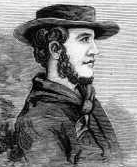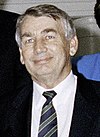Division of Batman
| Batman Australian House of Representatives Division | |
|---|---|
 Division of Batman (green) in Melbourne, Victoria | |
| Created | 1906 |
| Abolished | 2019 |
| Namesake | John Batman |
| Electors | 108,935 (2016) |
| Area | 66 km2 (25.5 sq mi) |
| Demographic | Inner metropolitan |
| Coordinates | 37°43′59″S 145°00′50″E / 37.733°S 145.014°E |
The Division of Batman was an Australian Electoral Division in the state of Victoria. It took its name from John Batman, one of the founders of the city of Melbourne. The division was created in 1906, replacing the Division of Northern Melbourne, and was abolished in 2019 and replaced by the Division of Cooper.[1]
The division was located in Melbourne's northern suburbs. It covered an area of approximately 66 square kilometres (25 sq mi) from Thomastown/Bundoora in the north to Clifton Hill in the south, with Merri Creek providing the vast majority of the western boundary and Darebin Creek, parts of Macleod and Plenty Road in Bundoora providing the eastern boundary. The suburbs of Alphington, Clifton Hill, Fairfield, Kingsbury, Northcote, Preston, Reservoir, and Thornbury; and parts of Bundoora, Coburg North, Macleod, and Thomastown were in this division.[1]
Held by Labor for all but 10 years of its history, Batman traditionally had been a safe Labor seat. However, the Greens made the seat a contest beginning with the 2010 election, where they reduced Labor from a 26.0% margin to a 7.9% margin. Though Labor increased their margin against the Greens to 10.6% in 2013, the Greens reduced Labor's margin to just 1.0% in 2016. At the 2018 Batman by-election however, Labor increased their margin to 4.4% against the Greens.[2]
In June 2018, the Australian Electoral Commission announced that, at the 2019 Australian federal election, the division would be re-named Cooper, after Aboriginal community leader and activist William Cooper.[3]
History[edit]

When it was created it covered the inner suburbs of Carlton and Fitzroy, but successive boundary changes moved it steadily northwards, ending with it including Northcote, Preston, Reservoir and Thornbury.
Located in Labor's traditional heartland of north Melbourne, Batman had been in Labor hands for all but two terms since 1910, and without interruption since 1969. It was held by Brian Howe from 1977 to 1996, a senior minister in the Hawke and Keating governments, and also Deputy Prime Minister 1991–95. Howe was succeeded at the 1996 election by Martin Ferguson, moving to Parliament after six years as President of the ACTU. Ferguson served as a senior Labor frontbencher, and a minister in the Rudd and Gillard governments, before resigning from the ministry in March 2013 after the failed challenge to Gillard's leadership. He was succeeded at the 2013 election by former Senator David Feeney, who had been a parliamentary secretary in the Rudd and Gillard governments.[4]
In 2018, as a result of the 2017–18 Australian parliamentary eligibility crisis, Feeney resigned and decided not to seek pre-selection to run at the ensuing by-election. The 2018 Batman by-election held on 17 March saw the election of Labor's Ged Kearney.[2]
Members[edit]
Election results[edit]
| Party | Candidate | Votes | % | ±% | |
|---|---|---|---|---|---|
| Labor | Ged Kearney | 36,840 | 43.14 | +7.87 | |
| Greens | Alex Bhathal | 33,725 | 39.49 | +3.26 | |
| Conservatives | Kevin Bailey | 5,471 | 6.41 | +6.41 | |
| Animal Justice | Miranda Smith | 2,528 | 2.96 | +1.29 | |
| Rise Up Australia | Yvonne Gentle | 2,217 | 2.60 | +2.60 | |
| Independent | Teresa van Lieshout | 1,245 | 1.46 | +1.46 | |
| Liberty Alliance | Debbie Robinson | 1,186 | 1.39 | +1.39 | |
| Sustainable Australia | Mark McDonald | 951 | 1.11 | +1.11 | |
| Adrian Whitehead | 745 | 0.87 | +0.87 | ||
| People's Party | Tegan Burns | 496 | 0.58 | +0.58 | |
| Total formal votes | 85,404 | 93.79 | +1.57 | ||
| Informal votes | 5,650 | 6.21 | −1.57 | ||
| Turnout | 91,054 | 81.40 | −8.28 | ||
| Two-candidate-preferred result | |||||
| Labor | Ged Kearney | 46,446 | 54.38 | +3.35 | |
| Greens | Alex Bhathal | 38,958 | 45.62 | −3.35 | |
| Labor hold | Swing | +3.35 | |||
References[edit]
- ^ a b "Profile of the electoral division of Batman (Vic)". Current federal electoral divisions. Australian Electoral Commission. 2 October 2013. Retrieved 23 November 2013.
- ^ a b "Batman by-election: Labor's Ged Kearney wins seat as Bill Shorten declares: 'We are back'". Retrieved 18 March 2018.
- ^ "Names and boundaries of federal electoral divisions in Victoria decided". Australian Electoral Commission. 20 June 2018. Retrieved 20 June 2018.
- ^ Green, Antony (11 October 2013). "Federal election 2013: Batman results". Australia Votes. Australia: ABC. Retrieved 23 November 2013.
- ^ "Batman By-election". AEC Tally Room. Australian Electoral Commission. Archived from the original on 20 March 2018. Retrieved 18 March 2018.












